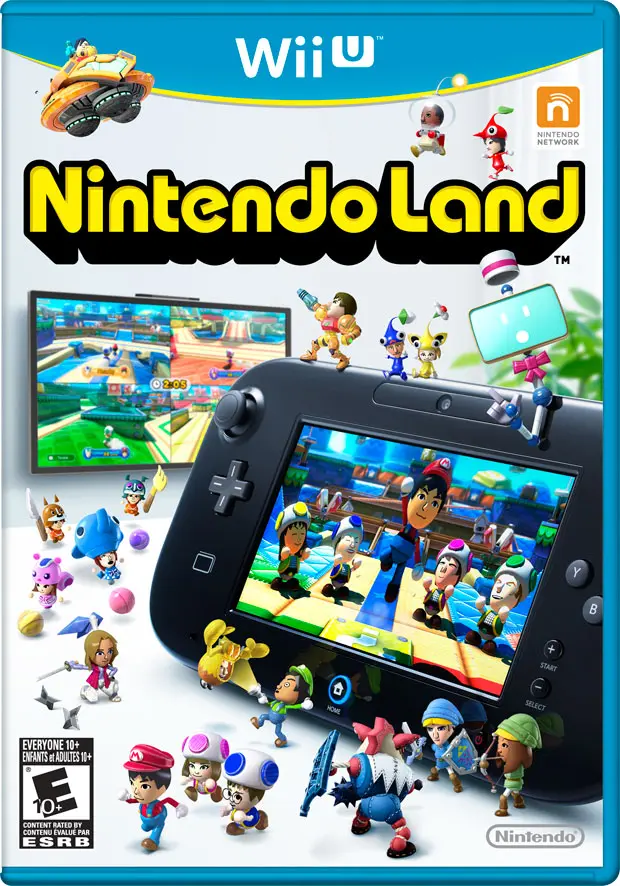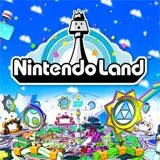 Nintendo Land is the byproduct of Nintendo’s Wii U tech demos from E3 2011, a collection of Nintendo property-branded mini-games designed to showcase individual features of the Wii U GamePad. It performs this duty well enough, as did Wii Sports for the original Wii console. The big difference between these pack-in games is Wii Sports was a go-to Wii game for several years and a system-seller. Nintendo Land and its mostly brief attractions are destined to be quickly forgotten once the novelty wears off in favor of more compelling software and design.
Nintendo Land is the byproduct of Nintendo’s Wii U tech demos from E3 2011, a collection of Nintendo property-branded mini-games designed to showcase individual features of the Wii U GamePad. It performs this duty well enough, as did Wii Sports for the original Wii console. The big difference between these pack-in games is Wii Sports was a go-to Wii game for several years and a system-seller. Nintendo Land and its mostly brief attractions are destined to be quickly forgotten once the novelty wears off in favor of more compelling software and design.
As its name implies, Nintendo Land is the Mario version of an amusement park that houses 12 attractions around a circular concourse with a central tower. The attractions offer a variety of gameplay options, from quick and easy to more involved, and single-player to up-to-five players. There’s a little something for every configuration of as many as five players, but no flexibility within each attraction to meet the demands of every player configuration.
Navigating the concourse, full of Mii’s representing other real world players from the Miiverse if connected to the Internet, introduces the first unique GamePad functionality by placing the second-screen within a real-world three-dimensional space. By doing so, it is possible to stand near the center of the concourse and physically spin the GamePad 360-degrees to have a look at every attraction. There is only one real use for this feature which is minor, but its inclusion is a fun and straightforward way to integrate the GamePad from the get-go.
By sheer coincidence or cleverly disguised design, the attraction starring Mario is the most compelling and fun of the lot. In this attraction, the chaser has two minutes to capture the runner and win if they succeed, lose if they fail. The Wii U asymmetric gameplay twist is the runner has the GamePad and can see where up to four chasers wielding Wii Remotes are on a map only they can see. The chasers have a limited view of what’s in front of them on the television.
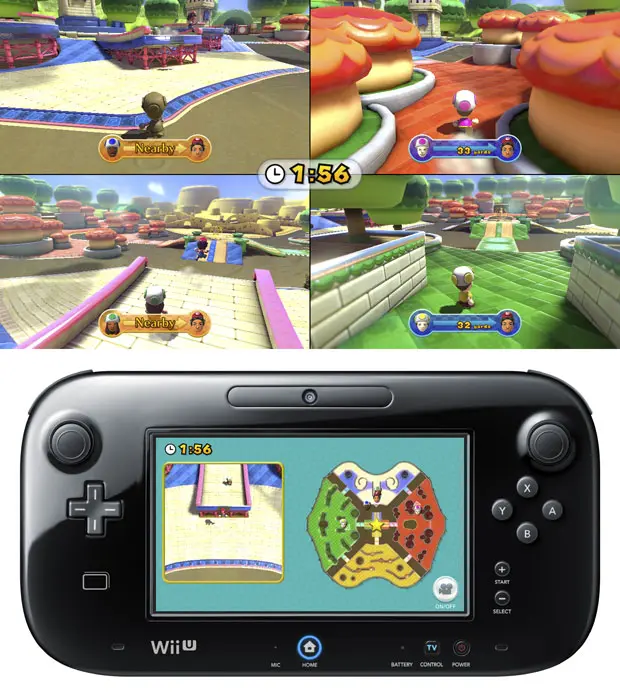
Mario Chase is the type of game that is brisk and frantic to play, scaling up in intensity with each additional chaser added to the mix. Those two minutes feel like an eternity for the runner as every turn and decision could mean the difference between victory and defeat.
Oddly enough, Mario Chase is one of three competitive games designed around chasing or avoiding the opponent, unfortunately combined representing all the competitive attractions and limiting any kind of adversarial variety in Nintendo Land. The other “chase” games, Luigi’s Ghost Mansion and Animal Crossing: Sweet Day, are moderately fun with their own unique take and twists on the recycled formula. Yet they lack the same sense of excitement and immediacy that Mario Chase and its ticking clock delivers.
Team attractions are a bit more complex to jump in and play, especially for the player wielding the GamePad. In The Legend of Zelda: Battle Quest, the GamePad player must move the controller around in front of them to pick targets for their arrows – which is no easy feat. The other 1 or 2 players get off easy with only having to swipe their Wii Remotes to swing a sword. Metroid Blast offers a similar dynamic where the GamePad is used to navigate a spaceship by moving it around, while the Wii Remotes are used to control players on the ground in a more traditional manner. Once again the Wii Remote players are strolling down easy street as the GamePad control learning curve is far steeper.
Pikmin Adventure dispenses with moving the GamePad around to offer a more sound cooperative experience. The GamePad player controls Captain Olimar and can use the touch-screen to call the other player, a Pikmin, to him, and then launch that player at a target with a tap of the touch-screen. The player controlling Olimar can also use a small swarm of Pikmins around him to attack enemies and collect Nectar to level up. This is the best team attraction of the bunch and makes the wait for Pikmin 3 all the more unbearable.
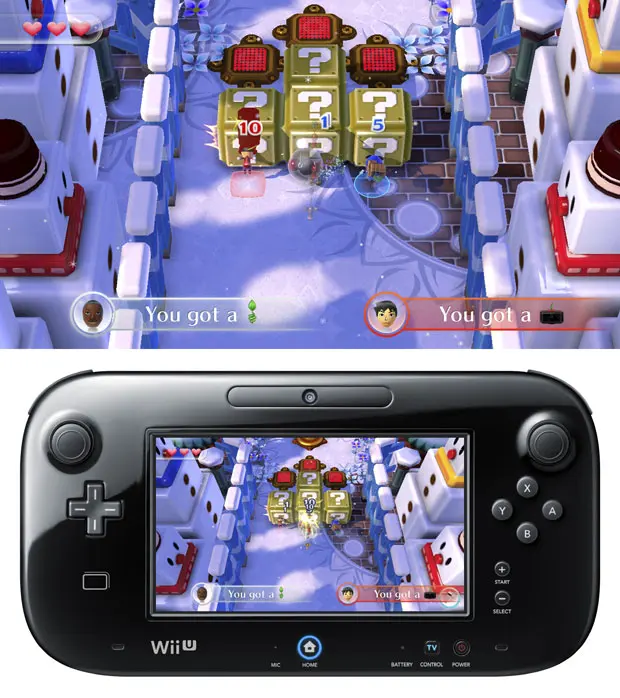
The remaining attractions are all single-player affairs and offer fairly simplistic jump in and jump out gameplay experiences. Balloon Trip Breeze requires swiping the touch-screen to create wind breezes to move through a level, and tapping the screen to take out obstacles. The latter becomes problematic as taking time to tap out an obstacle on the touch-screen temporarily takes focus away from where the balloon is carrying the player. It is moderately fun, though, and ramps up in difficulty fairly quickly.
Takamaru’s Ninja Castle also relies on touch-screen swipes, only here it is to toss throwing stars at enemies. This simple game feels like abusing the expensive GamePad more than anything else, and requires many swipes to complete from beginning to end due to its lack of pinpoint accuracy. Donkey Kong’s Crash Course uses the GamePad’s tilt functionality to steer a cart through a maze-like board and reach the end in a set period of time. It wins the award for easiest and most accessible attraction on the disc.
Octopus Dance, in contrast, wins the most pointless and thoughtless attraction. It’s a dance mimic game utilizing the analog sticks and up-down, left-right GamePad movements. The only real “innovation,” and I use that term loosely, is the player sees themselves from behind on the GamePad while the TV shows the player from the front. F-Zero makes an appearance in Captain Falcon’s Twister Race, a simplistic racer controlled by moving the GamePad around while holding it in a vertical position.
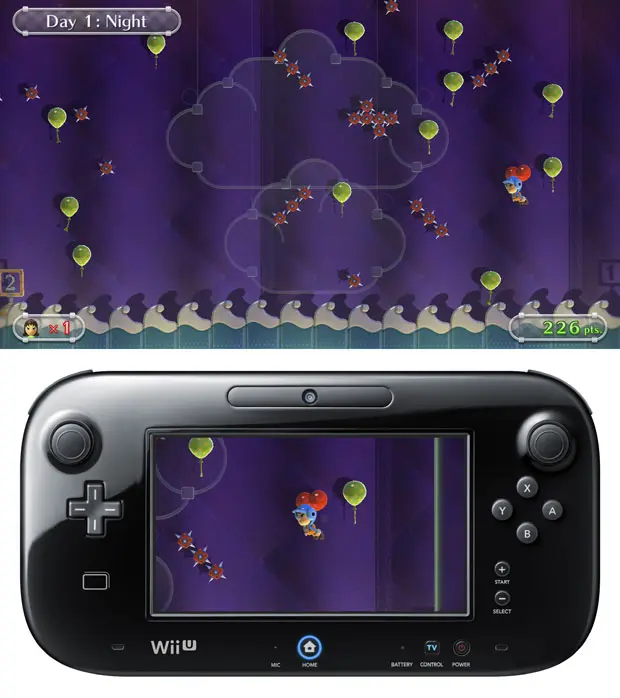
Yoshi’s Fruit Cart is nothing more than a tracing game using the GamePad and a stylus, aimed at a decidedly younger crowd used to similar experiences on DS or 3DS. It requires near perfection with the pen to touch every target on the touch-screen.
After circling through all the Nintendo Land attractions and opening up new boards, all of which can be accomplished in an afternoon, the big question becomes, “now what?” There are coins earned after each attraction played and even more if stamps ala Wii Sports Resort are unlocked, coins that can be used to play a Plinko-like 8-bit game to unlock presents to decorate the concourse Animal Crossing-style. Some of you will appreciate this and pursue it, while others will ignore it entirely. Unless Nintendo decides to overhaul the concourse, there is no space for any additional attractions via the Nintendo eShop.
With New Super Mario Bros. U also a Wii U launch title and offering, in my opinion, more fun and collaborative multiplayer play, Nintendo Land feels like a one-hit wonder after a couple strolls through the attractions. Nothing on the single-player side demands honing skills or additional practice like Wii Sports bowling did, and the multiplayer games are only worth breaking out at infrequent gatherings of friends or family. Once all of the GamePad features are explored and understood, which Nintendo Land successfully offers, the allure to return is remarkably dim.
– Dan Bradley
Shop for Nintendo Land with free shipping at Amazon.com (November 18, 2012 release date).
